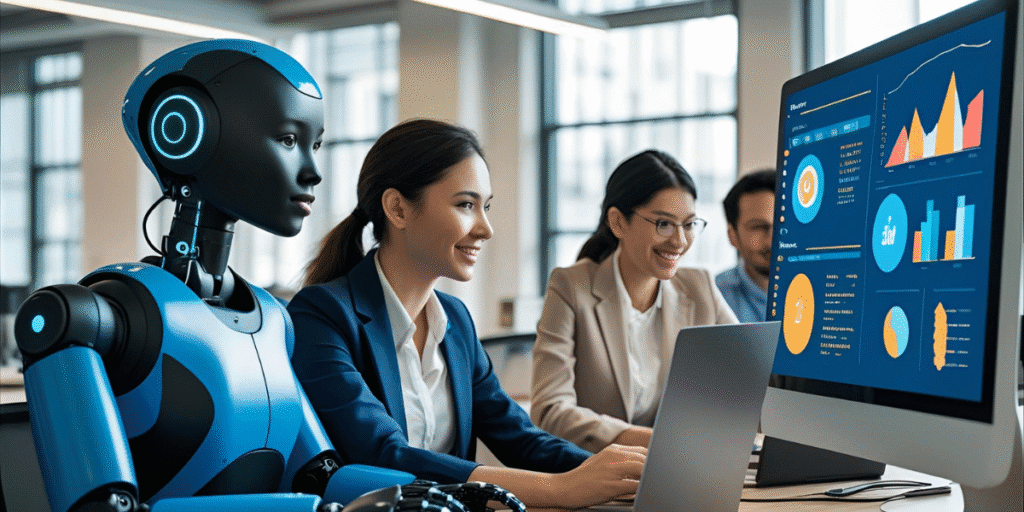On October 13, 2022, the landscape of U.S. businesses underwent significant transformation as Artificial Intelligence (AI) and automation technologies became increasingly integrated into a variety of industries. These technologies, which were once seen as futuristic, quickly evolved into critical tools for enhancing business operations and reshaping workforce dynamics. From improving productivity to creating new roles, AI and automation revolutionized the way businesses functioned across the country.
The Adoption of AI and Automation Across Industries
AI and automation technologies gained traction in many sectors in October 2022, driven by the need to streamline operations, increase productivity, and stay competitive. The ability of AI to analyze massive amounts of data and generate insights in real time became invaluable for decision-making. Automation allowed businesses to reduce reliance on manual tasks, minimize errors, and improve efficiency.
Several industries were at the forefront of this technological shift, seeing the most immediate impact:
- Finance: AI tools helped financial institutions enhance fraud detection, automate compliance checks, and improve customer interactions. With AI-driven predictive analytics, businesses could make better investment decisions and provide personalized financial services to clients.
- Healthcare: In healthcare, automation and AI contributed to advancements in medical diagnostics, personalized care, and operational efficiency. Routine administrative tasks such as scheduling and billing were increasingly automated, allowing healthcare professionals to focus more on patient care and treatment.
- Retail: Retailers began utilizing AI to improve inventory management, personalize customer experiences, and optimize supply chains. AI-powered chatbots and virtual assistants played a significant role in customer service, reducing the need for human intervention while ensuring a more responsive service.
- Manufacturing: Automation in manufacturing, particularly through robotics and predictive maintenance, transformed production lines. These technologies allowed manufacturers to reduce downtime, increase throughput, and maintain quality control with minimal human input.
The Shift in Workforce Dynamics
As businesses adopted AI and automation, the impact on the workforce was both positive and challenging. The increased efficiency of AI and automation allowed companies to lower costs and improve productivity, but it also led to the displacement of certain jobs, particularly those that involved repetitive tasks.
Job Displacement vs. Job Creation
The most visible effect of automation was job displacement, particularly in sectors where routine tasks could be replaced by machines. Administrative positions, such as data entry clerks and customer service representatives, were among the first to be automated. In manufacturing, robots replaced workers in repetitive and physically demanding roles.
However, the shift to AI and automation also resulted in the creation of new tech-driven roles. As companies sought to implement and maintain AI systems, they increasingly required employees skilled in AI development, data analysis, and machine learning. Positions in AI research, software engineering, and cybersecurity became more common as businesses needed experts to handle the complexities of these technologies.
While the disruption was evident in some sectors, the net result was a shift in the types of jobs available. This highlighted the need for workforce upskilling and reskilling initiatives to help employees adapt to the changing job market.
Efficiency and Cost Savings
A significant benefit of AI and automation was the dramatic increase in efficiency and the cost savings realized by businesses. Automation allowed companies to streamline processes, reduce human error, and achieve a higher level of consistency in their products and services.
In customer service, for example, AI-powered chatbots could answer common customer inquiries, reducing the need for human representatives. These systems could work 24/7, providing a higher level of service and enabling businesses to allocate human resources to more complex tasks. Similarly, AI’s ability to analyze customer data enabled businesses to create personalized experiences that were more engaging and relevant.
Additionally, AI-powered predictive analytics helped businesses in areas like inventory management and supply chain optimization. By forecasting demand and identifying potential issues before they arose, companies could make more informed decisions, reduce waste, and cut costs.
The Future of AI and Automation in Business
Looking beyond October 2022, it became clear that AI and automation were not passing trends but rather essential components of modern business. As technology continued to evolve, new tools and innovations, such as generative AI and advanced robotics, promised even greater potential for businesses to improve their operations.
However, the challenge for companies was not just adopting new technologies, but also ensuring that their workforce was prepared for these changes. The growing need for tech-focused roles meant that businesses would have to invest in employee development and create pathways for workers to acquire new skills. Those who were able to integrate AI and automation effectively into their workflows were better positioned for long-term success.
Conclusion
The impact of AI and automation on U.S. businesses on October 13, 2022, marked a pivotal shift in the way companies operated. The benefits—improved efficiency, reduced costs, and the creation of new tech-driven roles—were significant. However, the transition also required businesses to navigate challenges, including job displacement and the need for workforce upskilling. As we move further into the digital age, businesses that embrace these technologies while preparing their employees for the future will continue to thrive.
